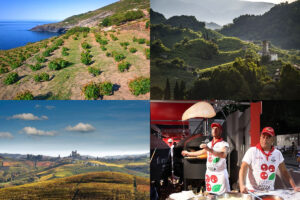The wine of the ancient Phoenicians has been “resurrected” from the ashes: the Whitaker Foundation, which is the group that safeguards the natural and cultural patrimony of the Island of Mozia, the historical-cultural pearl of the Mediterranean, has chosen the Sicilian winery, Tasca d’Almerita to manage the island’s vineyards.
The Island of Mozia, which is made up of a total of 40 hectares, is located near the northwestern corner of Sicily, near Trapani, and is one of the most important Phoenician settlements in the Mediterranean basin. Founded at the end of the 8th century as a strategic point of control for commercial routes in the Mediterranean, Mozia still holds an inestimably valuable historic treasure according to the archeological entity that is its custodian.
At the beginning of the 1900’s, the island was acquired by Englishman Joseph Whitaker who was attracted to its historic and archeological wealth. He created a museum and the Whitaker Foundation to which he entrusted the management of the entire island. As the moral entity for the Accademia Nazionale dei Lincei, the Whitaker Foundation has as its goal the cultivation of cultural activities, the study, and the diffusion of findings on the Phoenician civilization, which had one if it’s most important centers on the Island of Mozia.
And a fundamental aspect of the history of the island is its viticultural tradition. As early as 1875, Mozia was covered with vineyards, the vineyards that, now, Tasca D’Almerita will endeavor to revitalize by creating a wine that is capable of expressing the uniqueness of the land out of which they have grown.
The Whitaker family had long cared for these vineyards until they decided to give priority to archeological excavations instead. In 2007 the foundation decided, however, to give back this priority to the winemaking tradition of the island, entrusting the job to Tasca d’Almerita, one of the most important families of the Italian wine world.
Beginning their own winemaking traditions in the mid 1800’s, Tasca d’Almerita anticipated the international success and the interest in Sicilian wines by exploiting the enormous potential of the Regaleali estate.
Their success, which has continued to grow over seven generations, is, today, in the hands of Alberto and Giuseppe Tasca d’Almerita. As it is with all of the best European winemaking traditions, like that of French Chateaux, the family is involved in every step of the process, from the work that begins in the vineyards to that of the winery. Now, the dedication to this family tradition has allowed them to be entrusted with the task of regenerating a unique island territory, which includes 13 hectares of vineyards, of which 3 date back to the antique properties of the Whitaker family and the remaining 10 hectares have been re-planted after years of experiments.
The winemaking family will collaborate with supervisors from the Regional Institute of Vine and Wine and with consultant, Giacomo Tachis, one of the most accredited technicians of the wine sector. By the end of April 2008, the fruit of the efforts by the Tasca d’Almerita label who have a created a wine with the Island of Mozia’s Grillo grape, will be arriving on the market.
The History of the Vineyards on the Island of Mozia
The first vineyards of Grillo grapes on the Island of Mozia were most probably planted at the beginning of the 1800’s, when the English, who had arrived in Marsala, most probably recognized that the land and climate of the island were ideal for the production of wine that could compete with Madera and Port, which were the staple of the British navy. It cannot be excluded, however, that vineyards didn’t already exist on the island before the British arrived, though no official documentation has been found.
Certainly, with the passage of the entire property of the island to Giuseppe Whitaker, who came from an English family whose wealth was in part earned through the commerce of Marsala, the culture of winemaking would be maintained, making it probable the idea that there were already vineyards on the island during the Phoenician and Punic era, therefore, as far back as period between the 7th to 4th century B.C.
At the start of the millennium, the wine of Canaan (once called Phoenicia, where Lebanon is now) was renowned and in the cult of the divinities of the Syrian-Palestinian area there were always ritual offerings of wine, which was usually conserved in amphoras or large jars. This wine was most likely sweet or spiced wine.
For the period in question, archeological or epigraphic evidence has been found only in the western area of Sicily colonized by the Greeks and it cannot be confirmed whether the amphoras found on Mozia are of local production and whether wine was stored in them.
The cultivation of vineyards during the 20th century used the work of sharecroppers who took their part of the crops back along the “submerged roads” that the Phoenicians had constructed in the 6th century B.C. to connect the island to the mainland. Some of the names of these sharecroppers are still used to indicate the fields they cultivated and the warehouses they stored their goods in (like “Marino” and “Passalacqua”).
Obviously, it was agricultural work that allowed for the discovery of the remains of the ancient city of Mozia. In particular, the farmers that were conceded the land in the central area of the island discovered, in the 1920’s, a particularly beautiful bronze incense holder in the shape of a woman’s head.
It is also true that the archeological excavations, at times, have also contributed to a better understanding of the succession of varietals used in vineyards, as is the case in “Zone A”, where it was possible to identify the grape variety used in the 1920’s as well as the variety used in the vineyard preceding it.
As well as the warehouses in the fields, there was also a winery located in the center of the island, built by using an old farmhouse, constructed on the remains of the ancient city of Mozia. In the following years, during World War II, the increased production required additional construction and three cement silos were added.
In the 1970’s some vineyards (above all those located on the southern part of the island) died due to a drought and by the end of the century there remained only three hectares out of a total area of 40 hectares.
Winemaking on the island was thus interrupted and the two buildings that made up the winery were transformed into warehouses. And it was precisely here, during restoration work on these warehouses, that two blocks of the ancient city of Mozia were discovered below during a routine check of the building’s foundations. The city that dates back to between the beginning of the 7th century B.C. and the middle of the 4th century B.C.
At this point, it was decided that the area would become an archeological museum, and only one of the cement silos was conserved as a testimony to the activities that had taken place here for the past forty years.
In 1999 the Whitaker Foundation, with the go ahead given from the Superintendent of Cultural and Environmental Heritage of Trapani, began a project to replant the vineyards, which, today, occupy an area of 10 hectares.
Copyright © 2000/2025
Contatti: info@winenews.it
Seguici anche su Twitter: @WineNewsIt
Seguici anche su Facebook: @winenewsit
Questo articolo è tratto dall'archivio di WineNews - Tutti i diritti riservati - Copyright © 2000/2025








































































































































































































